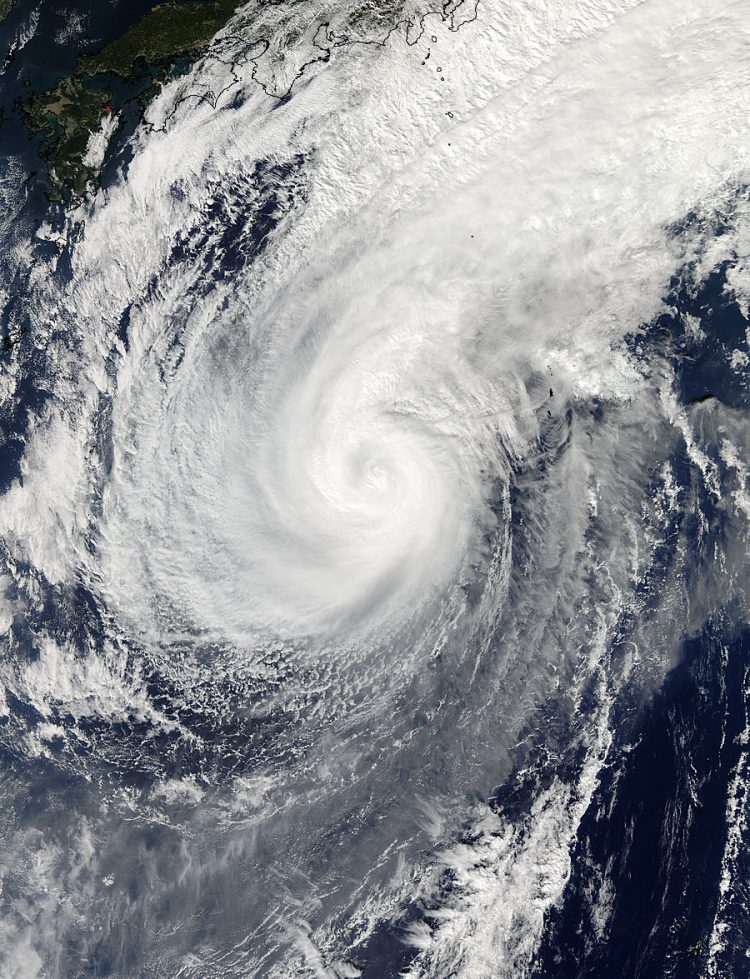NASA Sees Typhoon Nuri Pass Iwo To, Japan

NASA's Aqua satellite captured a visible picture of Typhoon Nuri on Nov. 5 at 4:10 UTC (11:10 p.m. EST, Nov. 4). Image Credit: NASA Goddard MODIS Rapid Response Team
The Moderate Resolution Imaging Spectroradiometer or MODIS instrument that flies aboard NASA's Aqua satellite captured a visible picture of Typhoon Nuri on Nov. 5 at 4:10 UTC (11:10 p.m. EST, Nov. 4).
At 1002 UTC (5:02 a.m. EST) a microwave image captured from NASA/JAXA's Tropical Rainfall Measuring Mission or TRMM satellite showed that the low-level center of circulation was beginning to weaken.
The strongest thunderstorms had become isolated in the northern quadrant of the storm. Regardless, a weak eye still appeared on the microwave imagery.
By 1500 UTC (10 a.m. EST) on Nov. 5, Nuri's maximum sustained winds had dropped to 80 knots (92 mph/148.2 kph) as a result of increased wind shear.
Nuri was centered near 27.2 north latitude and 139.2 east longitude. That's about 174 nautical miles (200 miles/322 km) northwest of Iwo To. Nuri was moving to the northeast at 10 knots (11.5 mph/18.5 kph).
Nuri is expected to continue weakening as it moves in a northeasterly direction, while remaining over open waters in the western North Pacific. Forecasters at the Joint Typhoon Warning Center also expect Nuri to begin transitioning into an extra-tropical storm over the next day or two.
Rob Gutro
NASA's Goddard Space Flight Center
Media Contact
More Information:
http://www.nasa.gov/content/goddard/nuri-western-pacific-ocean/All latest news from the category: Earth Sciences
Earth Sciences (also referred to as Geosciences), which deals with basic issues surrounding our planet, plays a vital role in the area of energy and raw materials supply.
Earth Sciences comprises subjects such as geology, geography, geological informatics, paleontology, mineralogy, petrography, crystallography, geophysics, geodesy, glaciology, cartography, photogrammetry, meteorology and seismology, early-warning systems, earthquake research and polar research.
Newest articles

Webb captures top of iconic horsehead nebula in unprecedented detail
NASA’s James Webb Space Telescope has captured the sharpest infrared images to date of a zoomed-in portion of one of the most distinctive objects in our skies, the Horsehead Nebula….

Cost-effective, high-capacity, and cyclable lithium-ion battery cathodes
Charge-recharge cycling of lithium-superrich iron oxide, a cost-effective and high-capacity cathode for new-generation lithium-ion batteries, can be greatly improved by doping with readily available mineral elements. The energy capacity and…

Novel genetic plant regeneration approach
…without the application of phytohormones. Researchers develop a novel plant regeneration approach by modulating the expression of genes that control plant cell differentiation. For ages now, plants have been the…





















